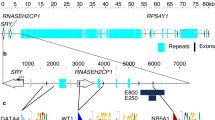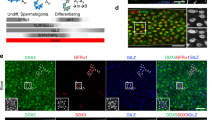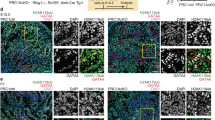Abstract
The Wilms' tumor 1 (WT1) and sex-determining region of the Y chromosome (SRY) genes are essential for development of the mammalian gonads and mutations in these genes are associated with gonadal dysgenesis in humans. The SRY gene encodes a transcription factor with one high-mobility group (HMG) box as a DNA-binding domain. WT1 encodes a transcription factor that contains four contiguous C2H2-type zinc-finger motifs as a DNA/RNA binding or protein–protein interaction domain. Here we report that WT1 binds to and acts synergistically with SRY to activate transcription from a promoter containing SRY-binding sites. This interaction is mediated by the WT1 zinc-finger domain and the SRY HMG box. WT1 mutants associated with Denys–Drash syndrome (DDS), which is characterized by Wilms’ tumor, pseudohermaphroditism, and nephropathy, fail to interact with SRY. Wildtype WT1 is recruited to SRY-binding sites in an SRY-dependent manner, whereas DDS mutants are not recruited as efficiently. These results suggest that WT1 forms a complex with SRY to regulate transcription and that this WT1-SRY interaction is important in testis development.
This is a preview of subscription content, access via your institution
Access options
Subscribe to this journal
Receive 50 print issues and online access
$259.00 per year
only $5.18 per issue
Buy this article
- Purchase on Springer Link
- Instant access to full article PDF
Prices may be subject to local taxes which are calculated during checkout



Similar content being viewed by others
References
Armstrong JF, Pritchard-Jones K, Bickmore WA, Hastie ND and Bard JB . (1993). Mech. Dev., 40, 85–97.
Call KM, Glaser T, Ito CY, Buckler AJ, Pelletier J, Haber DA, Rose EA, Kral A, Yeger H, Lewis WH, Jones C and Housman DE . (1990). Cell, 60, 509–520.
Drummond IA, Rupprecht HD, Rohwer-Nutter P, Lopez-Guisa JM, Madden SL, Rauscher III FJ and Sukhatme VP . (1994). Mol. Cell. Biol., 14, 3800–3809.
Dubin RA and Ostrer H . (1994). Mol. Endocrinol., 8, 1182–1192.
Ferrari S, Harley VR, Pontiggia A, Goodfellow PN, Lovell-Badge R and Bianchi ME . (1992). EMBO J., 11, 4497–4506.
Gessler M, Poustka A, Cavenee W, Neve RL, Orkin SH and Bruns GA . (1990). Nature, 343, 774–778.
Gubbay J, Collignon J, Koopman P, Capel B, Economou A, Munsterberg A, Vivian N, Goodfellow P and Lovell-Badge R . (1990). Nature, 346, 245–250.
Hacker A, Capel B, Goodfellow P and Lovell-Badge R . (1995). Development, 121, 1603–1614.
Hammes A, Guo JK, Lutsch G, Leheste JR, Landrock D, Ziegler U, Gubler MC and Sched R . (2001). Cell, 106, 319–329.
Hanley NA, Ball SG, Clement-Jones M, Hagan DM, Strachan T, Lindsay S, Robson S, Ostrer H, Parker KL and Wilson DI . (1999). Mech. Dev., 87, 175–180.
Hanley NA, Hagan DM, Clement-Jones M, Ball SG, Strachan T, Salas-Cortes L, McElreavey K, Lindsay S, Robson S, Bullen P, Ostrer H and Wilson DI . (2000). Mech. Dev., 91, 403–407.
Harley VR, Jackson DI, Hextall PJ, Hawkins JR, Berkovitz GD, Sockanathan S, Lovell-Badge R and Goodfellow PN . (1992). Science, 255, 453–456.
Harley VR, Lovell-Badge R and Goodfellow PN . (1994). Nucleic. Acids Res., 22, 1500–1501.
Herzer U, Crocoll A, Barton D, Howells N and Englert C . (1999). Curr. Biol., 9, 837–840.
Hossain A and Saunders GF . (2001). J. Biol. Chem., 276, 16817–16823.
Kent J, Coriat AM, Sharpe PT, Hastie ND and van Heyningen V . (1995). Oncogene, 11, 1781–1792.
Kim J, Prawitt D, Bardeesy N, Torban E, Vicaner C, Goodyer P, Zabel B and Pelletier J . (1999). Mol. Cell. Biol., 19, 2289–2299.
Koopman P . (1999). Cell. Mol. Life Sci., 55, 839–856.
Koopman P, Gubbay J, Vivian N, Goodfellow P and Lovell-Badge R. . (1991). Nature, 351, 117–121.
Koopman P, Munsterberg A, Capel B, Vivian N and Lovell-Badge R . (1990). Nature, 348, 450–452.
Kreidberg JA, Sariola H, Loring JM, Maeda M, Pelletier J, Housman D and Jaenisch R . (1993). Cell, 74, 679–691.
Larsson SH, Charlieu JP, Miyagawa K, Engelkamp D, Rassoulzadegan M, Ross A, Cuzin F, van Heyningen V and Hastie ND . (1995). Cell, 81, 391–401.
McElreavey K and Fellous M . (1999). Am. J. Med. Genet., 89, 176–185.
Moore AW, McInnes L, Kreidberg J, Hastie ND and Schedl A . (1999). Development, 126, 1845–1857.
Nachtigal MW, Hirokawa Y, Enyeart-VanHouten DL, Flanagan JN, Hammer GD and Ingraham HA . (1998). Cell, 93, 445–454.
Nakagama H, Heinrich G, Pelletier J and Housman DE . (1995). Mol. Cell. Biol., 15, 1489–1498.
Osaki E, Nishina Y, Inazawa J, Copeland NG, Gilbert DJ, Jenkins NA, Ohsugi M, Tezuka T, Yoshida M and Semba K . (1999). Nucleic Acids Res., 27, 2503–2510.
Patek CE, Little MH, Fleming S, Miles C, Charlieu JP, Clarke AR, Miyagawa K, Christie S, Doig J, Harrison DJ, Porteous DJ, Brookes AJ, Hooper ML and Hastie ND . (1999). Proc. Natl. Acad. Sci. USA, 96, 2931–2936.
Pelletier J, Schalling M, Buckler AJ, Rogers A, Haber DA and Housman D . (1991). Genes Dev., 5, 1345–1356.
Pontiggia A, Rimini R, Harley VR, Goodfellow PN, Lovell-Badge R and Bianchi ME . (1994). EMBO J., 13, 6115–6124.
Rauscher FJd, Morris JF, Tournay OE, Cook DM and Curran T . (1990). Science, 250, 1259–1262.
Sakamoto Y, Yoshida M, Semba K and Hunter T . (1997). Oncogene, 15, 2001–2012.
Scharnhorst V, van der Eb AJ and Jochemsen AG . (2001). Gene, 273, 141–161.
Semba K, Saito-Ueno R, Takayama G and Kondo M . (1996). Gene, 175, 167–172.
Shimamura R, Fraizer GC, Trapman J, Lau Yf C and Saunders GF . (1997). Clin. Cancer Res., 3, 2571–2580.
Sinclair AH, Berta P, Palmer MS, Hawkins JR, Griffiths BL, Smith MJ, Foster JW, Frischauf AM, Lovell-Badge R and Goodfellow PN . (1990). Nature, 346, 240–244.
Wagner KD, Wagner N, Bondke A, Nafz B, Flemming B, Theres H and Scholz H . (2002a). FASEB J., 16, 1117–1119.
Wagner KD, Wagner N, Vidal VP, Schley G, Wilhelm D, Schedl A, Englert C and Scholz H . (2002b). EMBO J., 21, 1398–1405.
Acknowledgements
We thank Drs M Yoshida, T Akiyama (Tokyo University), Y Kamachi, H Kondoh (Osaka University), K Nagai (Tokyo Medical University), N Takamatsu (Kitasato University), and K Morohashi (National Institute for Basic Biology) for providing materials and helpful discussions. We also thank Drs P Koopman (University of Queensland, Australia), A Menke (MRC, UK), and T Hunter (Salk Institute, USA) for critical reading of the manuscript. A Aono, N Hoshina, T Kimura, Y Wakabayashi, and M Yoshikawa provided excellent technical assistance. This work was supported by a grant provided by the Ichiro Kanehara Foundation (99KI005) and by a Grant-in-Aid for Scientific Research from the Minis-try of Education, Culture, Sports, Science, and Technology of Japan.
Author information
Authors and Affiliations
Corresponding author
Rights and permissions
About this article
Cite this article
Matsuzawa-Watanabe, Y., Inoue, Ji. & Semba, K. Transcriptional activity of testis-determining factor SRY is modulated by the Wilms’ tumor 1 gene product, WT1. Oncogene 22, 7900–7904 (2003). https://doi.org/10.1038/sj.onc.1206717
Received:
Revised:
Accepted:
Published:
Issue Date:
DOI: https://doi.org/10.1038/sj.onc.1206717
Keywords
This article is cited by
-
TET2 catalyzes active DNA demethylation of the Sry promoter and enhances its expression
Scientific Reports (2019)
-
SRY protein function in sex determination: thinking outside the box
Chromosome Research (2012)



